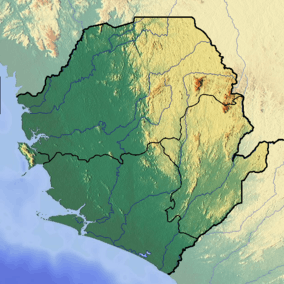Bumbuna Dam
| Bumbuna Dam | |
|---|---|
 Location of Bumbuna Dam in Sierra Leone | |
| Country | Sierra Leone |
| Location | Bumbuna |
| Coordinates | 9°4′17.38″N 11°43′22.43″W / 9.0714944°N 11.7228972°WCoordinates: 9°4′17.38″N 11°43′22.43″W / 9.0714944°N 11.7228972°W |
| Purpose | Power |
| Status | Operational |
| Construction began | 1990 |
| Opening date | 2009 |
| Construction cost | US$327 million |
| Dam and spillways | |
| Type of dam | Embankment, concrete-face rock-fill |
| Impounds | Seli River |
| Height | 88 m (289 ft) |
| Length | 440 m (1,440 ft) |
| Spillway type | Bell-mouth |
| Reservoir | |
| Total capacity | 445×106 m3 (361,000 acre·ft) |
| Catchment area | 3,920 km2 (1,510 sq mi) |
| Surface area | 21 km2 (8.1 sq mi) |
| Power station | |
| Commission date | 2009 |
| Turbines | 2 x 25 MW (34,000 hp) Francis-type |
| Installed capacity | 50 MW (67,000 hp) |
|
Website http://bumbuna.sl/ | |
The Bumbuna Dam is a concrete-face rock-fill dam on the Seli River near Bumbuna in Tonkolili District, Sierra Leone,[1] and 350 kilometres (220 mi) from the capital of Freeport, the main consumer.[2] The country's first hydroelectric dam, it supports a 50-megawatt (67,000 hp) power station.[1]
The site for the dam at Bumbuna Falls was first identified in 1971, and construction was begun in 1975.[3] Work was halted in May 1997, about 85% completed, due to the Sierra Leone Civil War, and did not restart until 2005.[3][4] The project was completed and went online in 2009.[5] Nearly a third of the dam's US$327 million cost ($103 million) was supplied by the African Development Bank.[3] A 26 January 2005 report noted that 33 villages would be affected by the dam, although only one (of 16 households and 135 people) would require resettlement.[6]
The dam has a maximum height of 87 metres (285 ft), a length of 400 metres (1,300 ft) at the crest and a volume of 2,500,000 cubic metres (88,000,000 cu ft).[2] The volume of the reservoir created is 410,000,000 cubic metres (1.4×1010 cu ft),[2] 428,000,000 cubic metres (1.51×1010 cu ft)[1] or 480,000,000 cubic metres (1.7×1010 cu ft).[4] There are two Francis turbines, each rated for 25 megawatts (34,000 hp).[3]
After completion, the project has been plagued with problems, and barely produces 10 megawatts (13,000 hp)[7] or 25 megawatts (34,000 hp)[8] as of 2013.
A second phase is planned, for a 110-megawatt (150,000 hp) power station.[9][10] In June 2011, the government announced it had awarded the $750 million Phase II project to Joule Africa, a UK-based company.[8] This will entail a second dam and plant.[8] Construction was set to begin in 2014 and continue on until at least 2017.[8]
References
- 1 2 3 Fid Thompson (9 February 2010). "Sierra Leone's Hydro-Power Dam Lighting Up Freetown". Voice of America.
- 1 2 3 "Bumbuna Hydroelectric Power Plant". Salini Impregilo.
- 1 2 3 4 "Bumbuna Hydroelectric Power Station, Tonkolili District, West Africa, Sierra Leone". power-technology.com.
- 1 2 "Bumbuna Hydroelectric Power Station, Tonkolili District, Sierra Leone". renewable-technology.com.
- ↑ "Sierra Leone (11/15/11)". United States Department of State.
- ↑ Dr. Robert Zwahlen (26 January 2005). "Bumbuna Hydropower Project: Resettlement Action Plan for the Reservoir and Dam Area" (PDF). p. I.
- ↑ Kemo Cham (25 February 2013). "Why Sierra Leone's energy crisis just about got worse". africareview.com.
- 1 2 3 4 Kimberly S. Johnson (11 September 2013). "Sierra Leone's private sector rushes to fill the void as dam disappoints". The Africa Report.
- ↑ "Hydroelectric Plants in Africa - Guinea, Liberia & Sierra Leone". IndustCards. Retrieved 25 March 2014.
- ↑ "Bumbuna Hydroelectric Power Project Completion Report" (PDF). Bumbuna Hydro Electric Environmental And Social Management Project. Retrieved 25 March 2014.